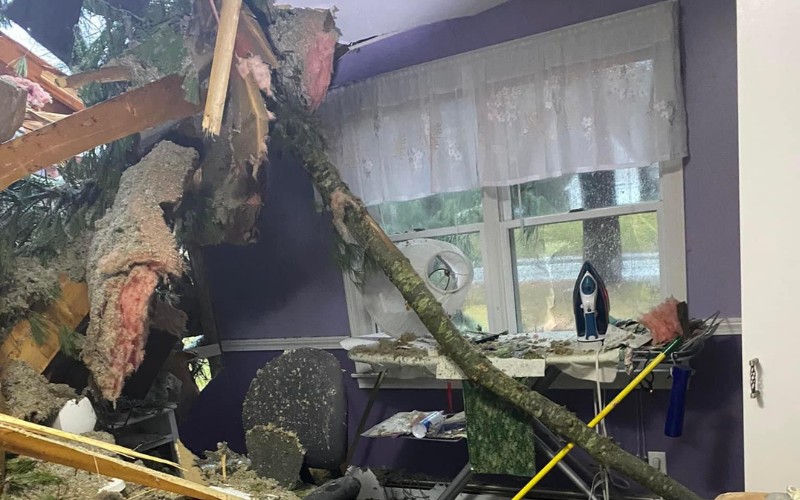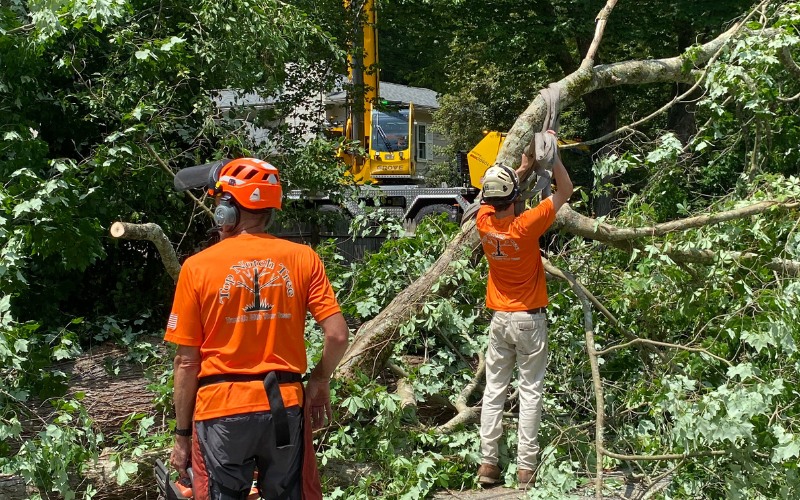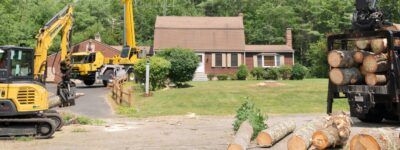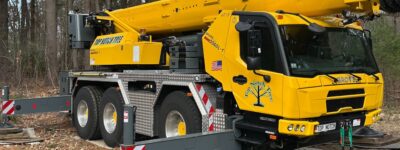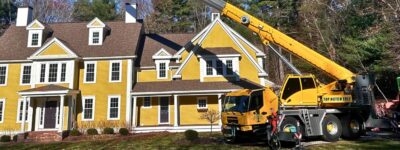If you’ve never experienced a tree emergency, it’s absolutely terrifying. Staring at a massive tree crushing your home sends panic shooting through your body as the fight-or-flight response kicks into overdrive. Even if you have been through this before, the shock and adrenaline can make it impossible to think clearly about what to do first.
That’s exactly why we partnered with our friend Matt Geraigery from Sabel Adjusters to create this guide. As tree care professionals, we’re often the first responders when disasters strike the South Shore, but there’s a critical process that happens after we remove the tree – one that can mean the difference between a smooth insurance claim and months of headaches.
Key Takeaways
- After a tree emergency, immediately call your insurance company and file a claim.
- Take thorough photos of all damage before cleanup begins to support your insurance claim.
- Arrange emergency services, like roof tarping and water removal, to prevent further property damage.
- Hire a professional tree company for safe removal and detailed documentation to avoid more costly issues.
- Working with a public adjuster, like Sabel Adjusters, can help ensure a smoother, fairer insurance settlement.
4 Steps to Take After a Tree Emergency
Once you’ve made sure everyone is safe, you need to focus on protecting your property. The decisions you make in the next few hours can make a huge difference in how smoothly your insurance claim goes and how quickly you get back to normal.
Here are four steps we recommend to every homeowner in the South Shore facing a tree emergency.
1. Contact Your Insurance Carrier and Open a Claim
This is your absolute first priority after ensuring everyone’s safety, and it needs to happen immediately – even if it’s in the middle of the night. Most major insurance companies operate 24/7 claim hotlines specifically for instances like this, so don’t wait until Monday morning or business hours.
When you call, have this information ready:
- The exact date and time the tree fell
- A clear description of what happened and the current weather conditions
- Your initial assessment of the damage you can safely observe
- Your contact information and current location if you’ve had to evacuate
The insurance representative will assign you a claim number – write it down and keep it handy, as you’ll need it for every future conversation. They’ll also typically ask if your home is safe to occupy and may provide guidance on emergency services if needed.
Starting this process immediately creates an official record with a timestamp, which can be crucial for your claim. Insurance companies also need to know about claims quickly to begin coordinating inspections and other services. So, the sooner you call, the sooner they can start helping you recover.
2. Take Photos and Document Everything You Can See
As Matt Geraigery always tells his clients, “Photos tell the story” when it comes to insurance claims. In the age of smartphones, your camera becomes one of the most important tools for protecting your financial interests. The goal is to create a comprehensive visual record of the damage before anything gets moved or cleaned up.
Essential photos to take include:
- Wide shots of the entire fallen tree from multiple angles
- Close-up photos of where the tree made contact with structures
- All exterior damage to your house, garage, shed, fence, or other buildings
- Interior damage from water infiltration, debris, or structural compromise
- Damaged vehicles, outdoor furniture, or other personal property
- The tree’s root system and point of origin (this can be important for determining the cause)
- Any obvious signs the tree was diseased, damaged, or healthy before it fell
Don’t worry about taking too many photos – your phone automatically timestamps and GPS-tags each image, creating an irrefutable record of what happened and when. Take photos from different distances and angles, and make sure to capture the full scope of the damage. You can always delete extras later, but you can’t go back and recreate the scene once cleanup begins.
If it’s dark or dangerous to get good photos immediately, take what you can safely and plan to get more comprehensive documentation once it’s light and safe to do so.
3. Arrange Emergency Services to Prevent Further Damage
Once you’ve documented the initial damage, your next priority is preventing additional damage to your property. This is a requirement of most homeowners insurance policies – you have a duty to protect your property from further harm once the initial damage occurs.
Common emergency services you might need include:
- Professional roof tarping if water is entering your home through damaged roofing
- Board-up services for broken windows, damaged doors, or compromised walls
- Water extraction and drying services if significant flooding has occurred inside
- Temporary power solutions if electrical systems have been damaged or compromised
Your insurance company may have a list of preferred emergency service vendors they work with regularly. These companies understand insurance procedures and can often bill your insurance company directly. However, you’re not required to use their preferred vendors – you can hire any licensed emergency service company you choose.
Keep detailed records of all emergency services, including receipts, invoices, and photos of the work being performed. Most homeowners insurance policies have specific coverage for emergency repairs designed to prevent further damage, and these costs are typically covered above and beyond your main claim.
Important: Don’t wait for your insurance adjuster to arrive before arranging emergency services. These are temporary measures to protect your property, and delaying them could result in additional damage that might not be covered.
4. Call a Professional Tree Company for Safe Assessment and Removal
Finally, you need a professional tree removal service to safely assess the situation and remove the fallen tree without causing additional damage. Removing a tree from your house isn’t like cutting down a healthy tree in your backyard. Emergency tree removal requires specialized equipment, extensive training, and years of experience to do safely without causing more damage.
After major storms, it’s not uncommon for so-called “tree professionals” to show up uninvited – chainsaws in hand, promising fast, cheap cleanup. But these storm-chasing crews often lack the training, certification, and insurance needed to safely handle dangerous tree removals. Don’t let urgency lead to bigger problems.
Here’s what a legitimate, professional company like Top Notch Tree provides during an emergency tree removal:
- A thorough safety assessment of the tree, surrounding structures, and any potential hazards
- Professional evaluation of the safest removal approach to minimize additional property damage
- Use of specialized equipment like cranes, bucket trucks, and rigging systems for controlled removal
- Complete debris cleanup, hauling, and site restoration
- Detailed documentation and photos for your insurance claim
- Coordination with insurance adjusters when they arrive for inspections
Every tree emergency situation is unique. We’ll work with you to determine the best timing and approach for your specific situation, always prioritizing safety for our crews and your property.
Does Homeowners Insurance Cover Tree Damage?
Most homeowners insurance policies cover tree removal and property damage when trees fall due to covered events like storms, high winds, or lightning. However, coverage can vary significantly between policies.
What is typically covered:
- Tree removal when it has damaged structures or blocks access
- Structural repairs to your home, garage, or other buildings
- Interior damage from water or debris
- Debris cleanup and disposal
Every insurance policy is different, and coverage details matter. This is where professionals like Matt Geraigery and his team at Sabel Adjusters can help ensure you receive fair treatment from your insurance company.
Frequently Asked Questions About Tree Emergencies
Should I wait for my insurance adjuster before removing the tree?
No, preventing further damage is your responsibility as a homeowner. Take photos first, then arrange for emergency tree removal and temporary repairs as needed.
How quickly can Top Notch Tree respond to emergencies?
We prioritize emergency calls and typically respond within a few hours when weather conditions are safe for our crews to work.
Will my insurance company pay for tree removal?
If the tree has damaged structures (including sheds, fences, and detached garages) or is blocking access to your home, removal costs are typically covered. Coverage varies by policy, so check with your insurance company.
How can a public adjuster help with my tree damage claim?
A public adjuster works for you, not the insurance company, to help negotiate your claim. They can be especially valuable for complex situations with extensive damage or when you’re not comfortable dealing with the insurance process yourself.
Matt Geraigery and his team at Sabel Adjusters specialize in helping homeowners in the South Shore get fair settlements from their insurance companies.
Don’t Handle This Alone – Call Top Notch Tree and Sabel Adjusters
Tree emergencies are overwhelming – physically, emotionally, and financially. But you’re not in this alone. From the moment disaster strikes to the final insurance payout, having experienced professionals by your side can make all the difference.
If you’re dealing with storm damage, don’t wait. Call Top Notch Tree at 781-871-8008 for fast professional emergency tree removal. And when it’s time to file your claim, connect with Matt Geraigery at Sabel Adjusters.
Stay safe, stay supported, and know that help is just a phone call away.

